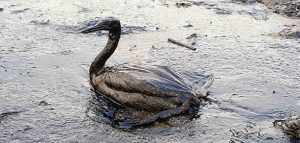Tag Archives: Woods Hole Oceanographic Institution
Scientists Hot on the Trail of Huge, Underwater Oil Plume In Gulf Of Mexico
Researchers backed by the NSF (National Science Foundation) and in conjunction with the WHOI (Woods Hole Oceanographic Institution) have discovered a plume of hydrocarbons which is more than 3,000 feet below the surface of the Gulf of Mexico and is thought to be 22 miles long at minimum. This plume is the residue of the BP Deepwater Horizon Oil Spill.
The 650 foot high, and 1.2 mile wide, plume of trapped hydrocarbons was discovered in the midst of a ten day subsurface sampling effort which took place from the 19th of June, until the 28th of June this year near the wellhead. The results have given a clear indication of where the oil has gone as the slicks on the surface have been shrinking and disappearing.
“These results create a clearer picture of where the oil is in the Gulf,” commented Christopher Reddy, a WHOI marine geochemist and one of the authors of a paper on the results that appears in this week’s issue of the journal Science.
This investigation – which was made possible by three quick action grants from the chemical and oceanography program at the NSF, with additional money made available by the US Coast Guard and NOAA via the Resource Damage Assessment Program – has confirmed that a large flowing plume was discovered which had
“petroleum hydrocarbon levels that are noteworthy and detectable,” Reddy explained.
So it seems we have not yet seen the end of the dreadful BP Oil Spill. While there has been no talk about what to do about this potentially disastrous situation, they are hard at work on it, but it could be months before an answer is found.
Health of marine phytoplankton can be assessed based on how they look form space
For the first time in history, scientists* have succeeded in measuring the physiology of marine phytoplankton through satellite measurements of its fluorescence. With this new tool, it will become possible for researchers to continuously keep an eye on the ocean’s health and productivity. Since it is based on satellite images the method works all over the world.
“Until now we’ve really struggled to make this technology work and give us the information we need,” says Michael Behrenfeld, an Oregon State University professor of botany. “The fluorescence measurements allow us to see from outer space the faint red glow of tiny marine plants, all over the world, and tell whether or not they are healthy. That’s pretty cool.”
Knowing how the world’s phytoplankton populations are doing doesn’t only tell us about the plankton it self; it also provides us with valuable clues that can help us assess a long row of other processes on the planet. By studying phytoplankton, it is for instance possible to learn about climate change and desertification.
* The break through is the result of the successful collaboration of Oregon State University, the NASA Ocean Biology and Biogeochemistry Program, the NASA Goddard Space Flight Center, University of Maine/Orono, University of California/Santa Barbara, University of Southern Mississippi, Woods Hole Oceanographic Institution, Cornell University, and the University of California/Irvine.
Mammal brains polluted with dangerous man-made chemicals
Researchers at Woods Hole Oceanographic Institution (WHOI) unveiled a hazardous cocktail of pesticides when analysing the brain matter of 12 marine mammals; eleven cetaceans and one gray seal stranded near Cape Cod, Massachusetts.
This is the most extensive study of pollutants in marine mammals’ brains and it confirms suspicions of marine mammals being the carrier of a vast array of different chemicals that have found their way into marine ecosystems.
Lead author Eric Montie analyzed the cerebrospinal fluid and the gray matter of the cerebellum in the twelve animals and found them to contain a long row of different man-made chemicals, including a group of especially widespread substances labelled “the dirty dozen” by environmentalists. Many countries banned the “the dirty dozen” as early as the 1970s due to their adverse effect on human health, but they are unfortunately still present in our environment.
Montie didn’t just test for the presence of certain chemicals; he also measured their concentration and found one instance where it was surprisingly high.
“The biggest wakeup was that we found parts per million concentrations of hydroxylated PCBs in the cerebrospinal fluid of a gray seal”, says Montie. “That is so worrisome for me. You rarely find parts per million levels of anything in the brain.”
PCBs are neurotoxicants known to disrupt the thyroid hormone system. Other examples chemicals found in the tested mammals are DDT (diklorodifenyltriklorethane), which can cause cancer and disturb reproduction, and PBDEs (polybrominated diphenyl ethers); a type of flame retardants known to impair the development of motor activity and cognition.
Co-author Chris Reddy, a senior scientist in the WHOI Marine Chemistry and Geochemistry Department, describes the new study as “groundbreaking because Eric measures a variety of different chemicals in animal tissues that had not been previously explored. It gives us greater insight into how these chemicals may behave in marine mammals.”
The results of this study was published online April 17 in Environmental Pollution.

